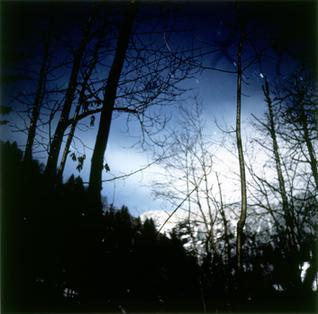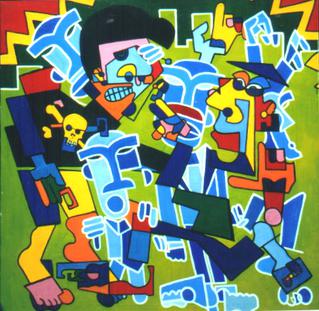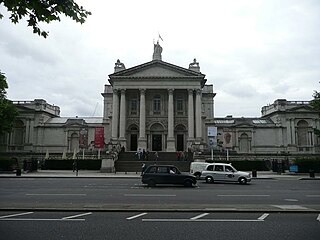Life and work
Phil Collins was born in Runcorn, England and now lives in Berlin. He studied drama and English at the University of Manchester, graduating in 1994. During his time there he worked as a cloak-room boy and barman at the Haçienda nightclub on Whitworth Street. After a stint teaching performance and film theory at Royal Holloway, University of London, he joined London-based performance group Max Factory whose live art projects were held all over the UK.
In 1998 he moved to Belfast to do a Master of Fine Arts at the College of Art and Design, part of the University of Ulster. His teachers included Alistair Maclennan and Willie Doherty. During his time in Northern Ireland he became an active member of the artist-run collective Catalyst Arts.
While still a student he was selected, as one of just four other artists from Northern Ireland, to show at Manifesta 3 in Ljubljana, Slovenia. He showed the first video he had ever made called How To Make A Refugee – an 11-minute film shot on the refugee camps at Stenkovec and Čegrane in Macedonia during the Kosovo crisis of 1999.
After completing his MA he spent some time living and working in Belgrade. In 2000 he was picked as one of the New Contemporaries and in the same year won the Absolute Prize. In 2001 he won a Paul Hamlyn Award for visual arts.
He was nominated for the 2006 Turner Prize for solo shows at Milton Keynes Gallery, Tanya Bonakdar Gallery, New York, and also for his work in the British Art Show 6. The Tate Gallery describes his work as "engaging photographic and video installations involving diverse social groups. Acting as a catalyst, he encourages people to reveal their individuality, making the personal public with sensitivity and generosity."
For his Turner Prize entry Collins created a fully functioning office called 'Shady Lane Productions' in the gallery at Tate Britain. [1] It was staffed with journalists and researchers who worked a normal 9am-5pm day, on full pay, for the duration of the show in full view of gallery visitors. These office workers were looking for candidates to appear in The Return of the Real, [2] a documentary about people whose lives had been ruined by reality TV. [3] Turner Prize judge Andrew Renton said, "To call Phil Collins a prankster would be to underestimate the seriousness of his work. His work is clearly political and connected to social engagement." [4]
In The Return of the Real, former participants from shows as diverse as Wife Swap , Brand New You, and Supernanny were given the opportunity to candidly recount their stories and air their grievances in unedited conversations with media lawyer Mark Stephens. Stephens said, "I am troubled by the way in which television has exploited its subjects in the cynical pursuit of commercial gain and infotainment. My interest in this project arises from those concerns and I was pleased to be able to help facilitate the voices of those involved, voices which are so often censored by the media which has already misrepresented them." [5]
His best-known works are video art, often featuring teenagers. In 2002 he travelled to Saddam Hussein's Baghdad, before the start of the Iraq War, and filmed Iraqis sitting silently for screen tests for a non-existent Hollywood movie (Baghdad Screen Tests, 2002). His best known work is They Shoot Horses (2004) consisting of two videos each lasting seven hours and shown at the same time on different walls. [6] This is a record of a disco dance marathon staged by the artist with nine Palestinians in Ramallah. [7] Music from the last three decades is played and the young people are captured in a single camera take, as they dance or, at times, stand round or slump to the floor. Another similar work was The World Won't Listen (2005), which features young people in Turkey, Colombia, and Indonesia performing karaoke versions of Smiths songs. [8]
About his work Collins has said, "A camera brings interested parties together. It attracts and repels according to circumstance or whim. A camera makes me interested in you and you maybe interested in me. In this sense, it's all about love. And exploitation. You could say that [this work] is driven by an emotional relationship with the subjects, rather than the rational or sensational standards of journalism, which also inhabit these territories."
Collins has been Professor of Video Art and Performance at the Academy of Media Arts Cologne since 2011.

The Turner Prize, named after the English painter J. M. W. Turner, is an annual prize presented to a British visual artist. Between 1991 and 2016, only artists under the age of 50 were eligible. The prize is awarded at Tate Britain every other year, with various venues outside of London being used in alternate years. Since its beginnings in 1984 it has become the UK's most publicised art award. The award represents all media.

Mark Wallinger is a British artist. Having previously been nominated for the Turner Prize in 1995, he won in 2007 for his installation State Britain. His work Ecce Homo (1999–2000) was the first piece to occupy the empty fourth plinth in Trafalgar Square. He represented Britain at the Venice Biennale in 2001. Labyrinth (2013), a permanent commission for Art on the Underground, was created to celebrate 150 years of the London Underground. In 2018, the permanent work Writ in Water was realized for the National Trust to celebrate Magna Carta at Runnymede.

Douglas Gordon is a Scottish artist. He won the Turner Prize in 1996, the Premio 2000 at the 47th Venice Biennale in 1997 and the Hugo Boss Prize in 1998. He lives and works in Berlin, Germany.

Gillian Wearing CBE, RA is an English conceptual artist, one of the Young British Artists, and winner of the 1997 Turner Prize. In 2007 Wearing was elected as lifetime member of the Royal Academy of Arts in London. Her statue of the suffragist Millicent Fawcett, popularly known as "Hanging out the washing", stands in London's Parliament Square.

Wolfgang Tillmans is a German photographer. His diverse body of work is distinguished by observation of his surroundings and an ongoing investigation of the photographic medium’s foundations.

David Hall was an English artist, whose pioneering work contributed much to establishing video as an art form.

Kutluğ Ataman is an acclaimed Turkish-American contemporary artist and feature filmmaker. Ataman's films are known for their strong characterization and humanity. His early art works examine the ways in which people and communities create and rewrite their identities through self-expression, blurring the line between reality and fiction. His later works focus on history and geography as man-made constructs. He won the Carnegie Prize for his works Kuba in 2004. In the same year he was nominated for Turner Prize for his work Twelve.
Richard Billingham is an English photographer and artist, film maker and art teacher. His work has mostly concerned his family, the place he grew up in the West Midlands, but also landscapes elsewhere.

Darren James Almond is an English artist, based in London. He was nominated for the 2005 Turner Prize.

Stuckism is an art movement that began in London, England, in 1999. In 2000, Melbourne artist Regan Tamanui started the first international branch of the movement. As of 2010, there are seven Australian Stuckist groups, who have held shows—sometimes concurrently with UK activities—received coverage in the Australian press and on TV, and also been represented in UK shows. The Stuckists take a strong pro-painting and anti-conceptual art stance, and were co-founded by Charles Thomson and Billy Childish.
Rebecca Jane Warren is a British visual artist and sculptor, born in Pinhoe, Exeter. She is particularly well known for her works in clay and bronze and for her arranged vitrines. The artist currently lives and works in London.

Stuckist demonstrations since 2000 have been a key part of the Stuckist art group's activities and have succeeded in giving them a high-profile both in Britain and abroad. Their primary agenda is the promotion of painting and opposition to conceptual art.

Stephen Purbeck Howarth, known as S.P., is a poet, Stuckist artist and actor. He was expelled from college for his paintings. He has demonstrated against the Turner prize at the Tate gallery.
Mark Leckey is a British contemporary artist. His found object art and video pieces, which incorporate themes of nostalgia and anxiety, and draw on elements of pop culture, span several works and exhibitions. In particular, he is known for Fiorucci Made Me Hardcore (1999) and Industrial Light and Magic (2008), for which he won the 2008 Turner Prize.

The 2008 Turner Prize was awarded on 1 December 2008 to Mark Leckey. The £25,000 Turner Prize is awarded by the Tate to one of four nominees and is based on their work in the previous year. The other three 2008 nominees were Runa Islam, Goshka Macuga and Cathy Wilkes; for the first time since 1998, there were three female nominees. The chairman of the jury was Stephen Deuchar, director of Tate Britain. The artwork shown by the nominees at the invitational exhibition was generally unpopular with critics.
There were four nominees for the 2006 Turner Prize for British contemporary art, and the winner was Tomma Abts.
Aldo Tambellini was an Italian-American artist. He pioneered electronic intermedia, and was a painter, sculptor, and poet. He died at age 90, in November 2020.
Andrea Büttner is a German artist. She works in a variety of media including woodcuts, reverse glass paintings, sculpture, video, and performance. She creates connections between art history and social or ethical issues, with a particular interest in notions of poverty, shame, vulnerability and dignity, and the belief systems that underpin them.
The 2013 Turner Prize was won by the French artist Laure Prouvost. The prize exhibition was held at Building 80/81, Ebrington Square in Derry~Londonderry, from 23 October 2013 to 5 January 2014, as part of the UK City of Culture celebrations. The building, a former army barracks converted into offices, was transformed into a temporary art gallery for the Turner show, and returned to offices afterwards The awards ceremony was held at Ebrington on 2 December 2013. It was the first-time the exhibition and prize ceremony were held outside England.
The BFI Gallery was the British Film Institute's contemporary art gallery dedicated to artists' moving image housed within BFI Southbank, the BFI's flagship venue in London, previously known as the National Film Theatre.












